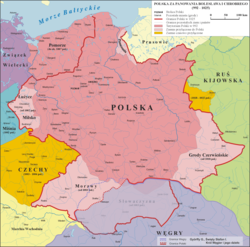Slovak lands
Slovak lands[1] or Slovakian lands[2] (Slovak: Slovenská zem or shortly Slovensko; Hungarian: Tótország;[3] Polish: Ziemia Słowacka[4] or shortly Słowaczyzna[5]) is the historical denomination for the whole of the Slovak-inhabited territories in Central Europe. It more or less corresponds to modern Slovakia and the adjacent territories in which autochthonous Slovak minorities live.[6]

Terminology
The term Slovak lands describes Slovak ethnic territory[7] claimed from the 5th century when Slavs inhabited these lands.[8] The Slovaks called their country 'Slovensko' (Slovakia) – the term appears in written documents from as early as the fifteenth century.[9][10]
History
The first known Slavic entities on the territory of Slovakia were the Samo's Empire in the 7th century, the Principality of Nitra founded sometime in the 8th century and Great Moravia in the 9th and early 10th centuries. The Slovak lands for 1000 years were an important part of the Kingdom of Hungary. During the 17th century many Germans settled into these areas.[11]
Autonomy of Slovak lands
Slovak lands acquired autonomous status within Hungarian Democratic Republic at March 11, 1919 by LEX No. XXX. after dissolution of the Kingdom of Hungary. Autonomy was signed by Hungarian president Mihály Károlyi and prime minister Dénes Berinkey.[12]
References
- Lauersdorf, M.R. (1996). The question of "cultural language" and interdialectal norm in 16th century Slovakia: a phonological analysis of 16th century Slovak administrative-legal texts. Verlag Otto Sagner. Retrieved 2015-04-10.
- Kollar, D. (2006). Looking at Slovakia. Oliver Press. p. 8. ISBN 9781881508496. Retrieved 2015-04-10.
- Szarka, L. (1999). Slovenský národný vývin: národnostná politika v Uhorsku 1867-1918. Kalligram Könyvkiadö. ISBN 9788071493181. Retrieved 2015-04-10.
- Orgelbrand, S. (1866). Encyklopedyja powszechna. 23. Orgelbrand. p. 620. Retrieved 2015-04-10.
- Bobrownicka, M. (1972). Zwia̜zki i paralele literatur polskiej i słowackiej. Ossolineum. Retrieved 2015-04-10.
- Uniwersytet Jagielloński. Studium Słowiańskie, Polska Akademia Nauk. Komitet Słowianoznawstwa. 1989.
- Kirschbaum, J.M.; Slovak World Congress (1978). Slovak Culture Through the Centuries: Proceedings of the Conference on Slovak Culture Held in Rome, Italy, Between June 21 and 23, 1975, Within the General Assembly of the Slovak World Congress. Slovak World Congress. Retrieved 2015-04-10.
- European Commission (1997). Commission opinion on Estonia's application for membership of the European Union: document drawn up an [sic] the basis of COM(97) 2006 final. Office for Official Publications of the European Communities. ISBN 9789282812815. Retrieved 2015-04-10.
- Teich, M.; Kováč, D.; Brown, M.D. (2011). Slovakia in History. Cambridge University Press. p. 3. ISBN 9781139494946. Retrieved 2015-04-10.
- Szende, László. "Szlovákok, tótok, tirpákok".
- Jan Owsinski, P.E. Ethnic Groups and Population Changes in Twentieth-Century Central-Eastern Europe. M.E. Sharpe. p. 104. ISBN 9780765618337. Retrieved 2015-04-10.
- "Herder-Institut: 404". herder-institut.de. Retrieved 2015-04-10.